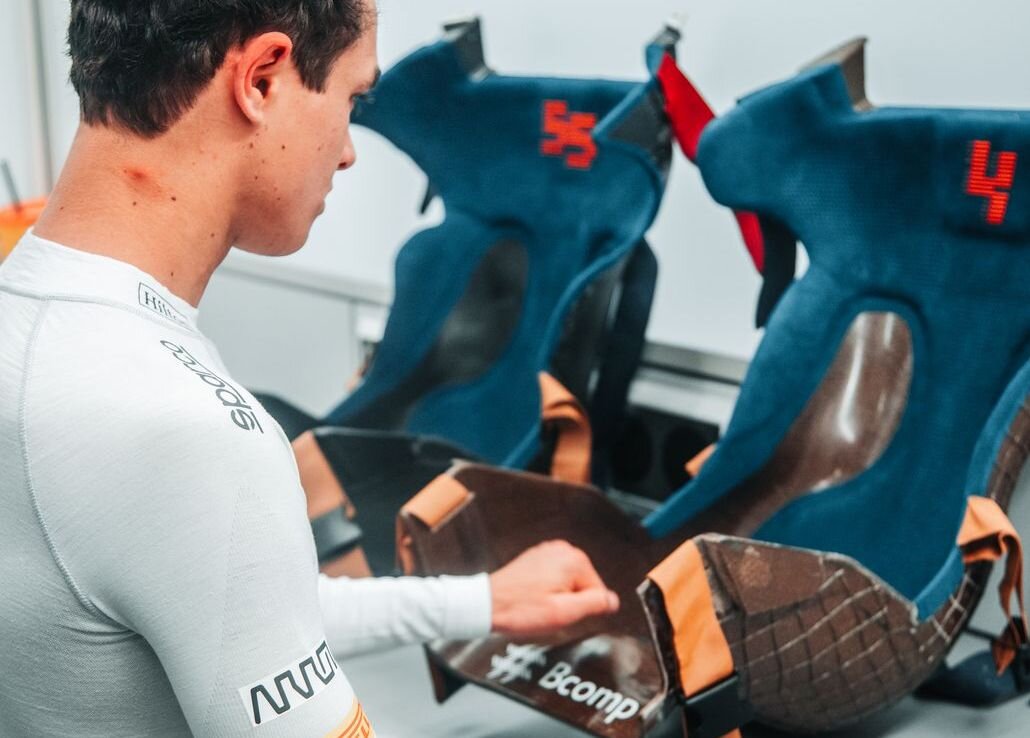Bcomp makes it to Formula 1
28.08.2020In 1981 McLaren transformed the Formula 1 by introducing the first car with a carbon fibre monocoque chassis. Now McLaren works on the next breakthrough. The racing team collaborates with Bcomp to develop F1's first natural fibre composite racing seat.

McLaren is working with Swiss sustainable lightweighting specialist Bcomp to develop a cheaper and more sustainable alternative to carbon fibre, starting with a natural fibre racing seat for Carlos Sainz and Lando Norris – the very first F1 car part to be made of renewable textile fibres. By optimising the mechanical properties of flax fibres through fabric architecture, it’s been possible to make a seat with the required strength and stiffness, but with a 75% lower CO2 footprint compared to its carbon fibre counterpart.
While the environmental benefits are clear, the mechanical properties of flax make it an attractive renewable raw material for high-performance composites. The tubular structure of flax fibres provides low density and high stiffness, which affords the opportunity to reduce weight while simultaneously improving vibration damping, as well as resistance to breakage, torsion and compression.
Flax fibres, for example, offer five-times better vibration damping thanks to Bcomp’s ampliTex flax fabric and powerRibs technology. Greater vibration absorption and impact resistance makes the natural fibre material well suited to use in the driver’s seat. It improves comfort and reduces vibration in the cockpit, which can have a fatiguing effect on drivers, especially over a race distance and particularly at circuits with aggressive kerbs.
Safety first
When it does break, unlike carbon fibre, it’s not prone to brittle fracture and splintering – a property that’s enhanced further by the structure of Bcomp’s powerRibs which stiffen and confine the damage zone. “The composite of ampliTex and powerRibs is not as fragile, and while it still breaks, the softer debris remains attached to the main structure with the help of the powerRibs, which help dissipate the energy,” explains Fischer.
The ductile fracture behaviour of natural fibre composites opens the door to other possibilities too. One of the most spectacular, but equally dangerous, aspects of an on-track incident are the shards of carbon fibre that result from a collision. Not only do they present an immediate risk to the drivers, they are notorious for causing punctures and leaving a driver’s race in tatters. By using natural fibre composites in other areas of the car, such as front wing endplates and the floor, it’s possible to reduce carbon fibre debris and therefore the risk of punctures.
Cost conscious
The advantages don’t stop there. With a budget cap set be introduced from 2021, many F1 teams will need to reduce costs while maintaining and improving performance – no mean feat in a sport where, typically, a team can pursue more development routes the more resource it has available. Teams are going to have to work even smarter, and with Bcomp’s ampliTex and powerRibs solutions reducing raw material cost by up to 30% compared to traditional carbon fibre, this significant saving can free up budget to explore other ways of improving car performance.
More application fields
The seat was run in pre-season testing without any problems and McLaren plans to be racing with Bcomp flax seats in the near future. And that’s only the beginning. “Where we see significant potential is in the non-critical, semi-structural areas of the car, such as the driver’s seat, as well as off the car,” says Bcomp CEO and Co-Founder Christian Fischer. And it’s the latter, reveals McLaren F1 Principal Composites Engineer Steve Foster, where the immediate scope for further adoption of natural fibre composites really lies: “When used intelligently, the flax fibres reduce weight and cost, while maintaining and, in some cases, even improving performance. There are a range of possible applications beyond the car itself, including pit gear, truck panels, packing cases, timing stands and mould tools.”
“The use of natural fibre composites is the latest example of pioneering, composite materials innovation at McLaren,” explains McLaren F1 Team Principal Andreas Seidl. “Not only does this solution provide equivalent performance to carbon fibre, it represents another step forward in our evolving sustainability programme, while underlining our commitment to helping F1 turn its ambitious sustainability strategy into action.”
(www.startupticker.ch)